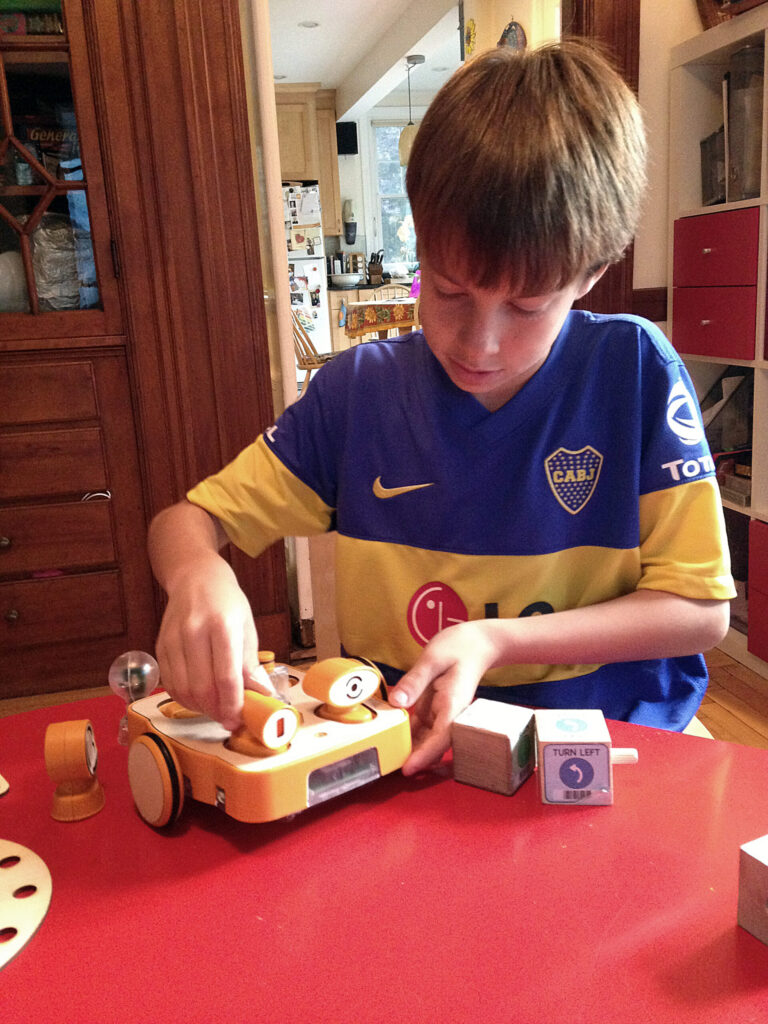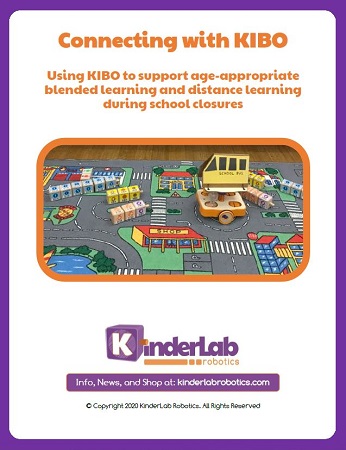Blending Blended Learning & KinderLab’s KIBO – the Screen-Free Coding Robot
 With this school year, learning in many schools and districts has been pushed outside of the traditional classroom and transferred to our homes or in a hybrid learning environment so it is more important than ever to reinforce for children that learning can occur ANYWHERE and can be led by adults and caregivers that aren’t always “teachers”. Given the educational uncertainty, it has become requisite to assemble a repository of educational tools and resources to help your child learn and keep them engaged. In the age of COVID-19, we have come to rely on technology as a supplement to traditional educational curriculum, so having accessible resources at home will prove invaluable in a remote or blended learning setting. Navigating school closures could be a lot easier if parents and teachers are armed with easy-to-use tools that they can incorporate into the prescribed curriculum.
With this school year, learning in many schools and districts has been pushed outside of the traditional classroom and transferred to our homes or in a hybrid learning environment so it is more important than ever to reinforce for children that learning can occur ANYWHERE and can be led by adults and caregivers that aren’t always “teachers”. Given the educational uncertainty, it has become requisite to assemble a repository of educational tools and resources to help your child learn and keep them engaged. In the age of COVID-19, we have come to rely on technology as a supplement to traditional educational curriculum, so having accessible resources at home will prove invaluable in a remote or blended learning setting. Navigating school closures could be a lot easier if parents and teachers are armed with easy-to-use tools that they can incorporate into the prescribed curriculum.
Be Prepared (It’s Not Just a Motto Anymore)
Since school districts across the country are going to be taxed with the CDC’s new guidelines and restrictions for in-school learning and slashed budgets for classroom materials, more of the responsibility of setting up productive learning environments for children will fall onto the shoulders of families and child caregivers. So, finding a tool that aligns with your state’s learning standards and STEM objectives, allows hands-on, creative learning through play, and promotes both parent-child and child-peer engagement through collaborative learning will lead to a productive and fulfilling learning experience at home.
One way to transcend these limitations is to invest in a simple learning tool that is also engaging for young children. KIBO, from KinderLab, is a robot kit specifically designed for early childhood, and is entirely screen-free, as children program their robots with “tangible code” made of wooden blocks. These materials allow children to engage with complex STEM concepts in computer science, engineering, and design thinking in an age-appropriate way without merely staring at a screen and having the technology do all the work.
Engage with Equity
When children learn from home and not in one shared location, there are some variables that cannot be controlled, making it an unlevel playing field. For example, many families lack reliable access to the internet or a computer at home, and not all districts can afford to allocate computers to every student. Thus, a resource like KIBO is an important move towards equity in learning across the community. Just like teachers would normally provide printed packets of work for students who do not have access to the school’s website pages or at-home printers, KIBO provides hands-on tools which enable kids to work at home and parents to support their children’s learning. In this sense, KIBO is a “1:1 for K-2” resource that puts age-appropriate learning technology into students’ hands with instructional support and parent engagement. KIBO provides prompts so parent and child can share in the learning process together. In fact, working with KIBO can demonstrate to younger children that it’s OK not to know everything and models a growth mindset to children. In fact, when working with parents as “co-learners”, children are more apt to explore with an open attitude.
Mastering the Models
With KIBO, STEM concepts can be built into lessons either in a blended learning model or a distance learning environment. Teachers can share resources and guidance via teleconference or can record videos, while the physical KIBO robot kits can rotate from home to home (after being cleaned and sanitized) for a “KIBO Home Visit” (i.e., take the “KIBO class pet” home), where they can use the robotics and coding activities with their parents In a hybrid or remote learning environment, teachers can use their own KIBO kit to provide teacher-led lessons with the student’s participation. For example, students can plan their coding sequence by working through an engineering journal and act out their own sequence, or play unplugged movement games, such as KIBO Says, where the teacher posts commands and kids follow the commands, i.e. Forward, Backward, Spin, or Shake!
In the Blended Learning environment, where students come to school on specific days and times with a smaller cohort, teachers can conduct small-group KIBO lessons using KinderLab’s Growing with KIBO curriculum book, promoting shared collaboration and social-emotional learning, even in a socially distanced classroom. Then, when the cohort rotates to the home environment on the remaining days of the week or cycle, students can continue to work on “unplugged” portions of KIBO projects, such as building decorations for their KIBO project with art materials.
In the Distance Learning model, teachers will have to conduct their STEM or technology and engineering lessons remotely. In this case, whole-group lessons can be delivered as either live videoconferences or recorded videos, where KIBO concepts are introduced and activities adapted from the curriculum. For example, the “KIBO Says” game can be played over videoconference, and followed up with a hands-on, self-directed activity with at-home KIBO kits. Also, many KIBO lessons include a suggested book to read at the outset when framing the lesson at a designated time (in place of in-class “circle time”). These readings translate very well to distance learning and can be downloaded from KinderLab Robotics’ KIBO STEAM Book List.
Download the whitepaper, Connecting with KIBO!
 Looking for guidance on how to implement a distance or blended learning program with KIBO? Our new whitepaper, Connecting with KIBO, outlines the benefits of providing access to robotics for young children and models for how to teach screen-free computer science and coding despite school closures. The whitepaper includes sample lessons and suggestions for using KIBO regardless of the setting: remote learning by videoconference, blended learning in reduced-occupancy classrooms, and parent/caregiver-facilitated learning at home!
Looking for guidance on how to implement a distance or blended learning program with KIBO? Our new whitepaper, Connecting with KIBO, outlines the benefits of providing access to robotics for young children and models for how to teach screen-free computer science and coding despite school closures. The whitepaper includes sample lessons and suggestions for using KIBO regardless of the setting: remote learning by videoconference, blended learning in reduced-occupancy classrooms, and parent/caregiver-facilitated learning at home!



















